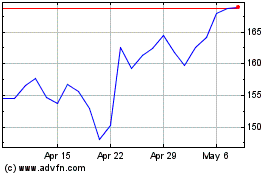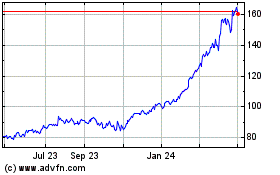By Michael Wursthorn and Akane Otani
The Dow Jones Industrial Average has ejected numerous blue-chip
industrial companies over the past decade, including miner Alcoa
Inc., Westinghouse Electric Corp. and this week General Electric
Co., in an effort to adapt a 19th-century index to a 21st-century
economy.
That path has become increasingly fraught, in part because of
the limitations of how the index is constructed.
Critics also contend the index's selection committee has been
removing troubled companies to avoid undermining the average's
long-term performance.
"Honestly, I didn't like the move," Robert Pavlik, senior
portfolio manager and chief investment strategist at SlateStone
Wealth, said of the decision to drop GE. "It's supposed to be an
industrial average that is reflective of the overall economy of the
United States, and if that's the case, then why replace it with a
Walgreens?"
Component stocks of the Dow are selected by the index committee,
a group that includes editors of The Wall Street Journal, which is
published by Dow Jones & Co., a part of News Corp.
Previous component swaps in the index tended to highlight a
particular company that had disrupted entire industries and
reshaped consumer behavior, like Visa Inc. and Microsoft Corp., or
sought to maintain a balance with a like-for-like replacement.
In 2015, AT&T Inc. was replaced with Apple Inc., which had
upended the technology and communications industries with its
iPhone and other mobile devices. Two years before that, the index
committee removed Bank of America Corp., which was still struggling
under the weight of the 2008 financial crisis, for a healthier
Goldman Sachs Group Inc., while Alcoa was replaced with
then-athletic apparel powerhouse Nike Inc.
The addition of Walgreens, however, has puzzled some investors.
The large retailer is part of the consumer-staple sector of the
stock market, which has struggled under the shadow of Amazon.com
Inc.'s e-commerce prowess.
"When you think about the direction the economy is going in, and
even the names that dominate the market today, you're not looking
at a drugstore retailer who very much itself could come under
threat from Amazon," said Michael O'Rourke, chief market strategist
at JonesTrading. "If you want to be representative of the economy
and where the economy is going, you gotta add them."
But its omission reflects the constraints of the Dow's
methodology.
Since the index's creation by Charles Dow, founding editor of
the Journal, the average has been price weighted, meaning the
bigger the stock price, the larger the sway for a particular
component, and vice versa. So Boeing, which is trading at $342.69 a
share, carries about 27 times more influence than GE at around
$12.88 a share. That is different from indexes such as the S&P
500, which are weighted by components' market capitalizations.
Although GE fell 45% last year, it barely made a dent in the
index. Caterpillar, meanwhile, has been one of the top stocks to
help yank the index higher despite having a market cap smaller than
the troubled conglomerate.
Amazon's stock price, currently about $1,750 a share, would
cause massive day-to-day gyrations in the Dow. If the company were
in the Dow on Wednesday, its less than 1% rise would have
contributed roughly 105 points to the Dow, which fell just 42
points during the session.
With Walgreens, consumer-staple stocks have four representatives
in the Dow, the same number of consumer-discretionary stocks,
financial firms, health-care companies and industrial companies
once GE was removed -- a more equal footing across sector lines
than in the S&P 500, which gives its heaviest weightings to
industrial, tech and financial companies.
Given the uncertain future of the sector, Walgreens could follow
the path of other Dow components that entered and left the index in
fairly brief fashion due to their shrinking size or turbulence
within the companies. Kraft Foods spent about four years in the
index before it was removed in 2012 after the spin off of its North
American grocery business, in favor of UnitedHealth. Bank of
America got five years.
The removal of troubled businesses appears to have helped keep
the index moving higher. The indexing committee made changes to the
Dow over eight separate years since 1998, and the index ended up
posting positive returns in six of those years.
Not all investors think GE's removal from the index cements its
status as an underperforming stock. In fact, S&P Dow Jones
Indices' latest decision has some investors feeling more optimistic
now about GE's odds of rebounding.
Going back to 1972, stocks that have been removed from the Dow
industrials have tended to outperform it over time, with companies
outpacing the blue-chip index by an average of 9.2% over the
following 12 months, according to an analysis by Ned Davis
Research.
To some investors and analysts, the trend suggests that the
index committee behind the Dow industrials has often mistimed its
decisions, removing a company before it has fully had a chance to
make a turnaround.
Analysts are predicting GE shares will rise over the short term,
with the mean price target for the stock clocking in at $16.42,
according to FactSet, 27% above their current price.
"It's certainly going to be a name that's on my radar," Mr.
Pavlik said. "When they kick it out of the Dow, I think it
highlights that it's probably near its bottom."
(END) Dow Jones Newswires
June 20, 2018 18:39 ET (22:39 GMT)
Copyright (c) 2018 Dow Jones & Company, Inc.
GE Aerospace (NYSE:GE)
Historical Stock Chart
From Mar 2024 to Apr 2024

GE Aerospace (NYSE:GE)
Historical Stock Chart
From Apr 2023 to Apr 2024
